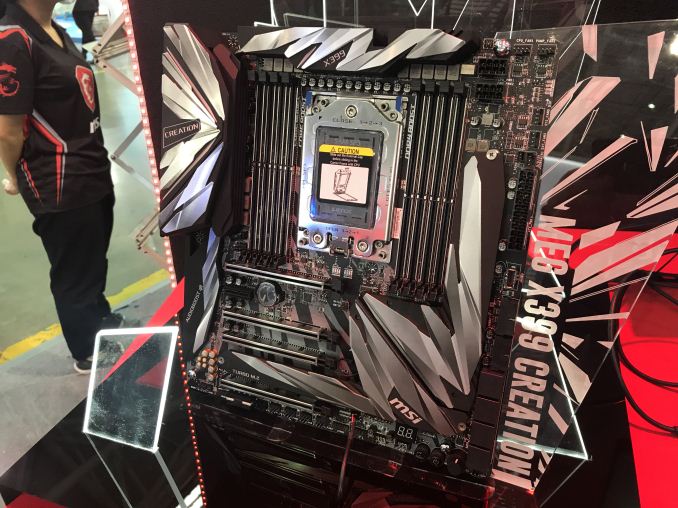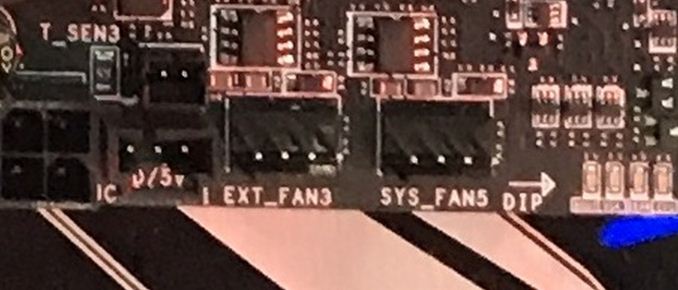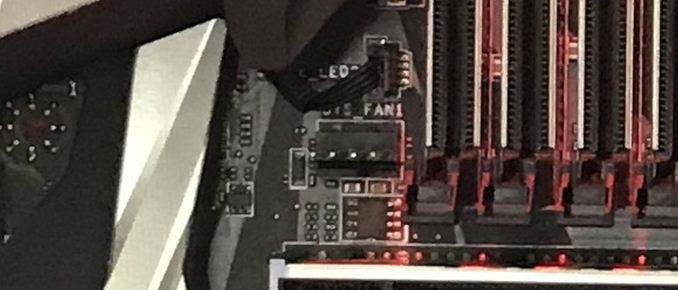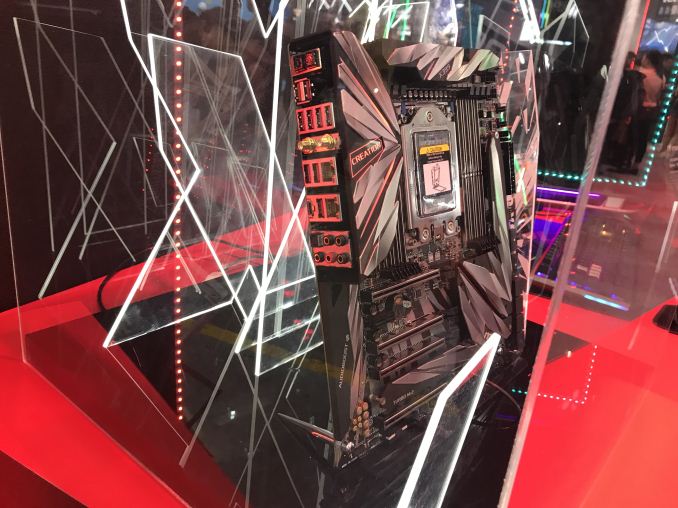MSI's New Threadripper 2 Motherboard on Steroids: X399 Creation
by Ian Cutress on July 2, 2018 9:00 AM EST- Posted in
- Motherboards
- AMD
- MSI
- Trade Shows
- X399
- Computex 2018
- Threadripper 2

One of the most impressive motherboard designs coming out of Computex was MSI’s new X399 Creation motherboard. With Threadripper 2 around the corner, sporting support for up to 32 cores and 250W TDP, a couple of the motherboard manufacturers are building X399 ‘refresh’ motherboards that are optimized for the new processors, and this is MSI’s very impressive effort.
The headline from this motherboard is the 19 power phases, arranged as 16 for the processor. This is likely a four-phase implementation with two doublers, but still comes in as eight more than the amount of phases for the CPU compared to any other Threadripper motherboard on the market. The effect of using more phases in this way means that the power multiplexing over time that occurs between phases gives each phase less time being the primary phase, as well as splitting the delivery with other segments, reducing the overall load and allowing for more headroom and/or better longevity. The power delivery is also sided with two 8-pin EPS 12V connectors.
The reason why most motherboard manufacturers only use eight is because the socket and memory design is bulky: ultimately there is only enough space for six phases, or eight if a smaller choke design is used. In order to fit sixteen, MSI has had to push the socket and memory down, forcing the manufacturer to choose to either lose one of the PCIe slots, or extend the board vertically (they seem to have done the latter). But this also gives the manufacturer a larger choice for phases and chokes with fewer space constraints, if a good enough power delivery heatsink is also applied. In these cases it sometimes requires more PCB layers to help with power/ground and routing, and MSI is using eight which is a high number for a consumer motherboard (usually 4-8, rarely 10), but not the highest (and server/workstation boards often use from 6 to 12 depending on the feature set).
On the board MSI is using a dual power delivery heatsink design, connecting the main power delivery heatsink by a heatpipe to a heatsink next to the rear panel that also helps to cool all the networking options. One thing to note is the styling on the heatsink and the board: it is very angled, and my feedback to MSI is that the board looks very busy. This is going to be MSI’s halo Threadripper 2 motherboard, and to be honest, the styling needs a good amount of work.
For a Halo motherboard, MSI is supporting four PCIe slots from the processor, although without water cooling only 3-way is going to be used due to PCIe slot spacing. Between the slots is an M.2 PCIe 3.0 x4 slot, with another slot actually next to the DRAM slots, as the board is also extended in width as well (making it E-ATX). MSI will be bundling its Quad M.2 PCIe 3.0 x16 card when the board is sold, giving a total of six M.2 slots. MSI says that it supports seven M.2 total, although the last one does not seem to be obvious, so it could be on the rear of the motherboard. There is no U.2 slot, as it seems that the form factor is basically dead for the consumer market.
For controllers, MSI has equipped the X399 Creation with dual Intel gigabit Ethernet ports, and an Intel 802.11ac Wi-Fi. For a halo motherboard I was expecting to see Aquantia’s 5G or 10G controller, however we do not get that here. There is no Thunderbolt either, but there are four USB 3.1 (10 Gbps) ports on the rear (one Type-C), and at least eight USB 3.0 ports, four or six of which on the back panel and two onboard headers for cases. There is also a Type-C onboard header, but it is not obvious if this is USB 3.0 or USB 3.1. Audio will be with an upgraded Realtek ALC1220 codec solution, with PCB separation between digital and analog signals and additional filter caps.
One, Two
Three, Four
Five
Six, Seven, Eight, Nine,
and Ten.
One of the features that MSI was keen to promote is that the board supports 10 fan headers in PWM mode but also three user-positioned thermal sensors that will be bundled in the box. This will allow users to define their thermal environment, with the software, how they need to.
We expect the MSI X399 Creation (or is it MSI MEG Creation?) to come to the market sometime soon, before the launch of Threadripper 2, or perhaps the same day as a launch partner with the processor. We expect a high price, although the lack of something like a 10G NIC will mean it won’t be super high.
| Want to keep up to date with all of our Computex 2018 Coverage? | ||||||
 Laptops |
 Hardware |
 Chips |
||||
| Follow AnandTech's breaking news here! | ||||||
























19 Comments
View All Comments
BigMama - Monday, July 2, 2018 - link
I got a feeling that since we haven't seen X499 board -this means that AMD decided to Add 8ch memory for the top line X499 for it's 32C 2990X , Mark my words!shabby - Monday, July 2, 2018 - link
Pipe dream, that's reserved for epyc including the 128 pcie lanes.Valantar - Tuesday, July 3, 2018 - link
8-channel for consumers (even professional workstation users who can use 32 cores) makes absolutely zero sense - workloads that can make use of that are pretty much server-exclusive (unless they're launching TR3 with integrated graphics :p). That would also likely make the board incompatible with previous TR chips given the differences in required pinouts. Not to mention the need for 10+ layer motherboards to route all those memory traces, ages of QC to verify signal integrity, and subsequent astronomical prices for a feature that <0.00001% of users would have any use for.I don't see that happening.
BigMama - Wednesday, July 4, 2018 - link
Look - EPYC ATX MB is same price as X399 MB's:https://www.amazon.com/Supermicro-MBD-H11SSL-I-B-E...
"feature that <0.00001% of users would have any use for."
It did't stoped Intel Shaw of 5GHZ 28 core CPU ...
but this feature will take the HEDT from Intel since the user know they will get TR3 with 48~64 core Drop-In next year.
tamalero - Saturday, July 7, 2018 - link
You forgot the price difference in processors.The 5Ghz gimmick was just an attention getter.. a very bad one. As everything about the test was cooked with very specified stuff to make it run.
prophet001 - Monday, July 2, 2018 - link
Is it a good idea to run 10 fans off of your motherboard's power delivery system?Heck running two fans has me sketched about the possibility of one of them failing and wiping the board out.
smilingcrow - Monday, July 2, 2018 - link
I've never heard of such a thing happening so is it common?12345 - Monday, July 2, 2018 - link
Depends on the fan, a 3000rpm noctua industrial fan only draws .3 amps and motherboard headers are usually 1-1.5 amp maximum. Then there's the delta fans that draw as much power as a cpu when running at full speed.Alexvrb - Monday, July 2, 2018 - link
A typical modern PWM fan header can run ~2-3 typical chassis fans without needing additional power. Obviously it depends on a number of factors but that's a good ballpark. With 10 fan headers you probably won't need to run more than one fan per header, and you'll have the headroom to run fairly powerful fans (by PC standards).If for some reason you need more than 10 fans, a GOOD PWM fan controller can control the speed of multiple fans off one PWM signal, while drawing power from the PSU directly. It will, however, only be able to report the speed of one of those fans... a limitation of our current PWM implementation.
What I'd like to see is an even smarter PWM fan controller that reports the speed of a particular fan (specific header), but reports 0 if ANY of the connected fans dies. That would eliminate my main complaint with using PWM controllers.
UpSpin - Sunday, July 8, 2018 - link
The Threadripper needs >200W, each PCIe Connector has to deliver at least 25W, I see 5 here, and one of them has to be able to supply a GPU with 75W, makes a total of 150W. One high power fan consumes 5W, so in total with 10 fans you have to supply additional 50W. I think that's easily doable. If such a fan fails, all it does is to kill the MOSFET.